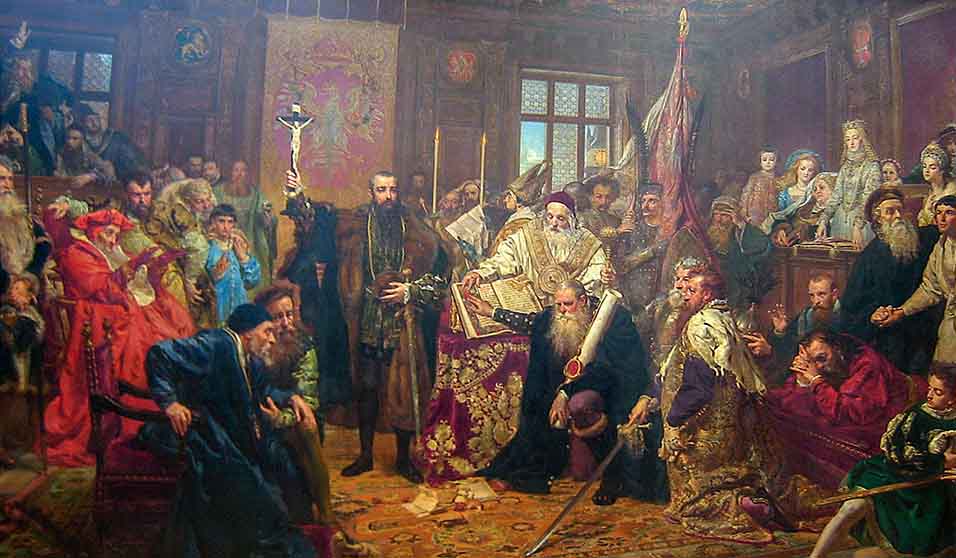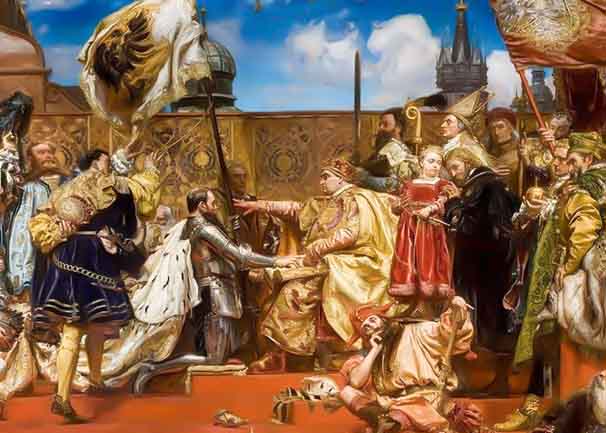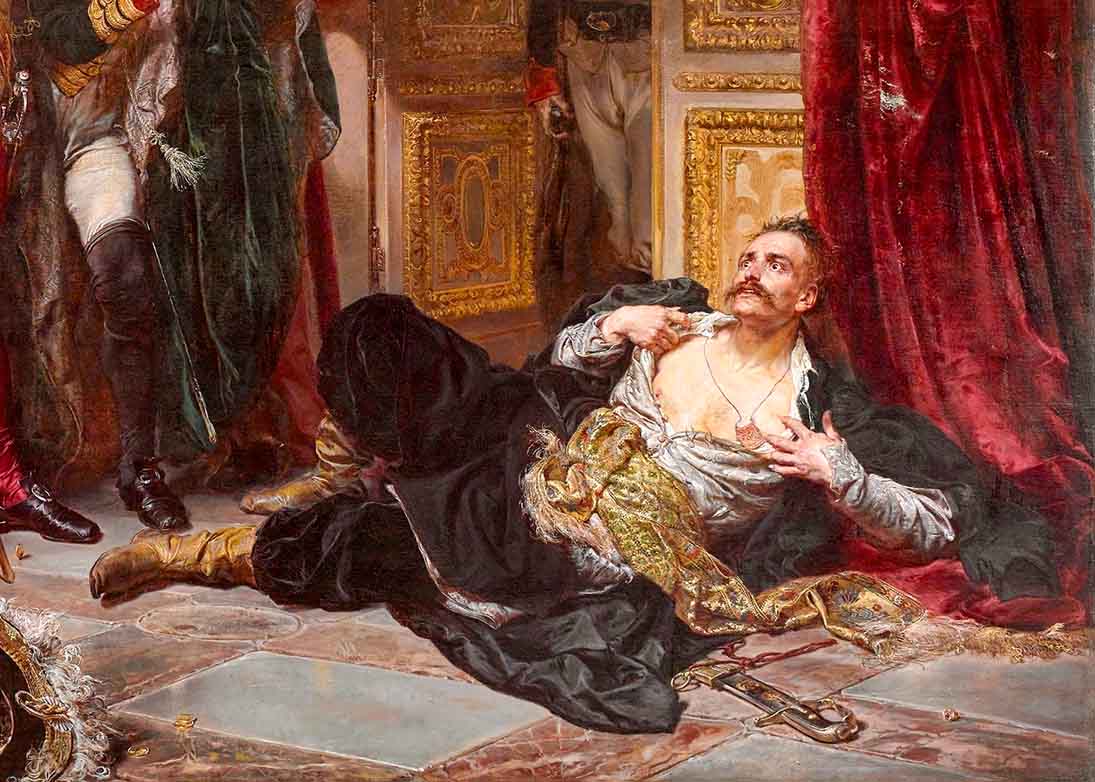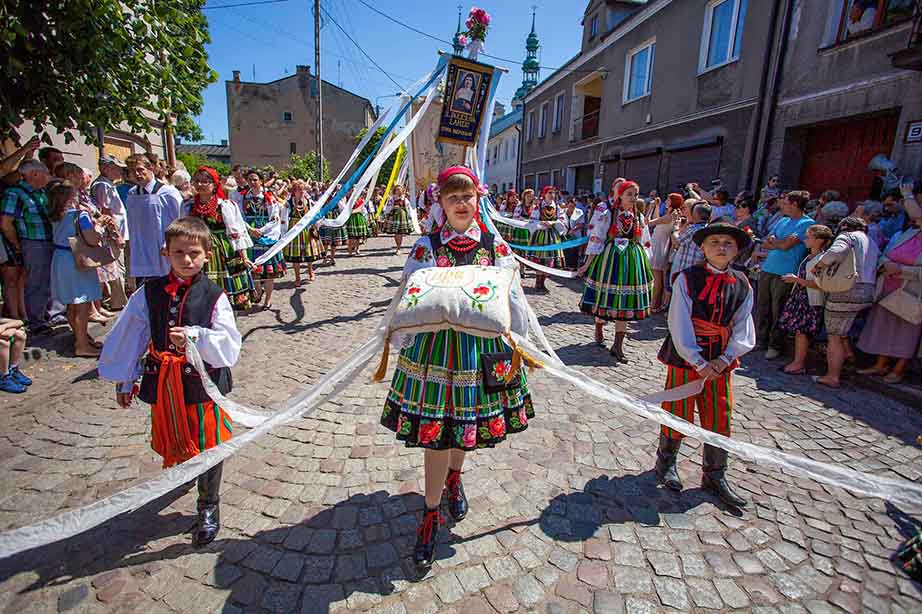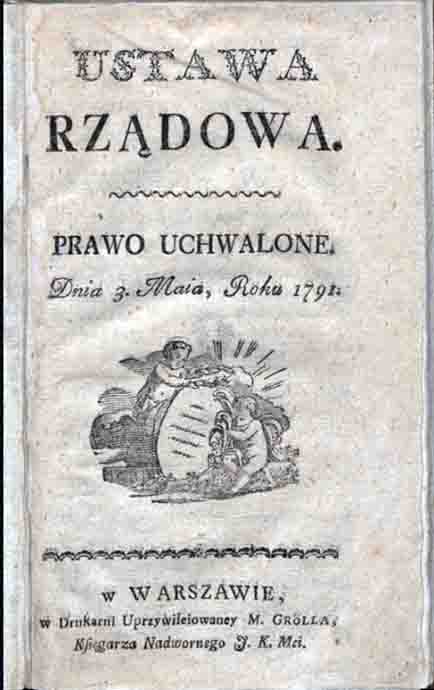The 3rd of May Constitution was the crowning achievement of the Great Sejm, also known as the Four-Year Sejm (1788-1792). In keeping with the spirit of the times, it introduced a tripartite division of power into executive, legislative and judicial branches. It established a constitutional monarchy - a peculiar novelty in Europe and the world. It abolished the liberum veto and free elections. It granted the principle of religious freedom while recognising Catholicism as the dominant religion. It gave the bourgeoisie the same civil rights as the nobility and opened the way for the ennoblement of its representatives. It provided for the protection of the peasantry. The constitution was adopted by acclamation in the Royal Castle in Warsaw when most of the opponents of the reforms were absent due to the Easter holidays.

Staging: A living painting for Matejko's painting, Photo. Grażyna Myślińska (Source: DlaPolonii.pl)
This act was a kind of coup d'état. The constitution transformed the state system and the social relations within it. However, it was the beginning of reforms, not the end. King Stanisław August Poniatowski (1732-1798), Marshal Stanisław Małachowski (1736-1809), the Enlightenment thinker Stanisław Staszic (1755-1826), the statesman and Enlightenment reformer Hugo Kołłątaj (1750-1812) and the patriotic politician and activist Ignacy Potocki (1750-1809) played an important role in the drafting of the Constitution. The adoption of the 3rd May Constitution was echoed by the leading thinkers of the time. Edmund Burke (1727-1797) - an Irish philosopher considered to be the founder of modern conservatism and a critic of the French Revolution - called the May 3rd Constitution 'the noblest good ever attained by any nation'. It was also praised by 'The Times' of London. The Act of Government lasted only one year, from May 1792. The reform project was interrupted by the Targowica Confederation, set up by opponents of the Constitution, and the War of 1792 in defence of the Constitution ended in the defeat of the Republic.
The impact of the 3rd of May Constitution was so strong that, for us Poles, it became a symbol of love for freedom and the homeland during the years of the partition of Poland and even later. As early as May 1791, a political party called the Assembly of Friends of the Constitution was formed. Symbolic marriages with the Constitution were organised throughout the country, and those who took part were given commemorative iron rings. The artist Jean-Pierre Norblin (1745-1830), who stayed in the Republic at the invitation of the Czartoryski family, dedicated a series of drawings to this momentous event. The best known of these is 'The Day of the Third of May MDCCXCI' by Romuald Gołuchowski. This atmospheric work, which speaks to the national memory, was quickly reproduced. On 2 May 1792, an engraving of the work was published by Józef Łęski (1760-1825) and sold widely at the price of 2 ducats.
One of the best-known pieces of music in Polish national memory is the 'Polonaise of the Third of May', composed especially for the occasion of the adoption of the Constitution. It was performed for the first time on 8 May 1791 in Kraków's Cloth Hall, at a ball held in honour of the Constitution and the King. The Polonaise of the Third of May was immortalised by Adam Mickiewicz (1798-1855) in Book XII of Pan Tadeusz, describing a concert given by the Jew Jankiel.
The Catholic Church was involved in promoting the Constitution, and Jews sang songs in the synagogues in its honour. Preparations were made for the celebration of the first anniversary of the Constitution in 1792 with great pomp. The foundation stone of the Temple of Divine Providence was laid as a votive offering in gratitude for this important piece of legislation. Unfortunately, these plans were thwarted by the unfavourable political situation, the division within the Republic and the hostile attitude of the neighbouring states. Targowica, war and another partition of Poland hung in the air. We had to wait until 2016 for the Temple of Divine Providence in Warsaw.
Few people know, however, that in Poland we have a monument of gratitude for the 3rd of May Constitution in the form of a church built much earlier, on the 100th anniversary of its celebration in 1891. We are talking about the Sanctuary of Our Lady of Sorrows and the Minor Basilica in Limanowa. How did it come about that a memorial in the form of a shrine in honour of this fundamental law was erected in this district town of about 15,000 inhabitants in the south of Poland? The co-author of the Constitution, Marshal Stanisław Małachowski, was the owner of the village of Dobra near Limanowa, and the parish priest of Limanowa, Father Kazimierz Łazarski (1858-1944), decided to draw on this heritage. The temple was designed by Zdzisław Mączeński (1878-1961). The monumental character of the building is determined by the magnificence of its façade and tower. On the pediment of the basilica, there is a shield with a white eagle in the crown and the dates 1791-1891. The temple was finally opened to the faithful on 6 October 1918, a few days before Poland regained its independence. On 3 May 1991, the anniversary of the Constitution, Pope John Paul II raised the church to the rank of a minor basilica.
The 100th anniversary of the 3rd of May Constitution was marked by another great work of art - a painting by Jan Matejko (1838-1893), an artist who shaped the historical imagination of the Polish people. His works have always aroused great interest. The artist immortalised the scene of the march to the Collegiate Church of St John the Baptist after the adoption of the Constitution. It is a complete work, depicting not only the historical moment itself but also the entire historical context of the constitution's creation, which is why Jan Dekert, who had died the previous year fighting for the rights of the bourgeoisie, is also depicted in the painting. Matejko immortalised both the people involved in the creation of the Constitution and those of symbolic importance. The central figure of the painting is Stanislaw Małachowski, immortalised in bright clothes, proudly presenting the document of the Constitution and carrying the Marshal of the Sejm on his shoulders. King Stanisław August Poniatowski, wearing a red mantle and with his hands outstretched for a kiss, enters the church on the steps. Behind him, there is Hugo Kołłątaj, co-author of the Constitution.
The painting unleashed a wave of patriotic feelings. From 1891, it was widely exhibited in Lviv and Krakow. In the 1920s, it came to Warsaw, where it was exhibited in the Sejm and 'Zachęta'. Hidden under the floorboards, there the canvas survived the Second World War. From 1945, it was exhibited in the National Museum in Warsaw. Jan Matejko dreamed the painting would be shown in the Royal Castle in Warsaw. This dream came true in 1984, when the Castle, freshly rebuilt after the destruction of the war, managed to place the work in the room in front of the Senators' Hall, where the 3rd of May Constitution was adopted. It can still be admired there today.
Three original copies of the 3rd of May Constitution have been kept in the Archives of Historical Documents in Warsaw to this day. The memory of the constitutional ideals played an integrating role in the absence of an independent state. Today, it is a lesson and an example for us. It is a testimony to our ancestors' love of country, courage and dedication to matters of great importance.







